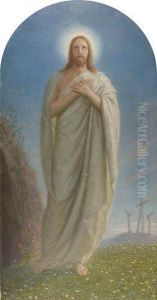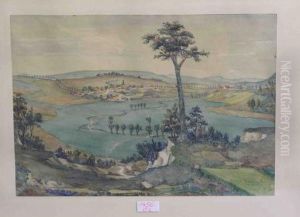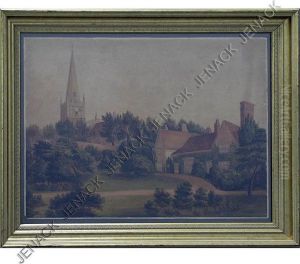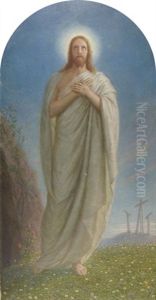Anton Dietrich Paintings
Anton Dietrich was a German painter, born in the year 1833 in Meißen, a town known for its porcelain production in Saxony, Germany. His life and career were emblematic of the 19th-century European art scene, heavily influenced by the Romantic and Realist movements that swept through the continent during his lifetime. Dietrich's work often reflected a deep engagement with both the beauty of nature and the intricacies of human emotion, hallmarks of the Romantic sensibility, while also demonstrating a commitment to realism in his depiction of subjects.
Dietrich received his formal art education at the Dresden Academy of Fine Arts, one of the premier art schools in Germany. It was here that he honed his skills under the tutelage of renowned artists of the time. His education laid a solid foundation for his artistic career, equipping him with both the technical skills and the creative vision necessary to make a significant impact on the German art scene.
Throughout his career, Anton Dietrich was known for his landscape and genre paintings, imbuing each piece with a sense of narrative and emotional depth. His landscapes, in particular, were celebrated for their ability to capture the sublime beauty of nature, a key aspect of Romantic art. These works often featured dramatic skies, lush forests, and serene waterways, all rendered with meticulous attention to detail and a vibrant palette that brought the scenes to life.
In addition to landscapes, Dietrich also excelled in genre painting, a style that focuses on scenes of everyday life. His genre paintings are notable for their depiction of the simple, often overlooked moments of human experience, imbued with a sense of warmth and familiarity that resonated with viewers. Through these works, he demonstrated a keen observation of social interactions and an ability to capture the nuances of human emotion, skills that elevated his art beyond mere representation to something that spoke to the viewer on a deeper level.
Anton Dietrich's contributions to the German art world were recognized in his time, and he participated in numerous exhibitions, gaining notoriety and accolades for his work. Despite the shifts in artistic trends towards the end of the 19th century, Dietrich remained true to his Romantic and Realist roots, continuing to produce works that reflected his deep love for nature and his insightful observations of human life.
He passed away in 1904, leaving behind a legacy that has continued to inspire and influence artists and art lovers alike. Dietrich's paintings are a testament to the enduring appeal of Romantic and Realist art, capturing the beauty of the natural world and the complexity of the human experience with sensitivity and depth.



